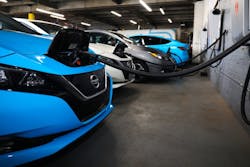Brooklyn-based Vehicle-to-Grid Bidirectional Station Charging back into NYC Grid
Three energy transition companies are partnering on the first vehicle-to-grid (V2G) program connecting back into the New York City grid.
Revel, NineDot Energy and Fermata Energy have deployed a bidirectional charging system at Revel’s Red Hook, Brooklyn warehouse. The system can both charge electric vehicles and discharge them to send electricity from their batteries back into the ConEdison’s grid when needed.
The V2G system uses three Fermata Energy bidirectional chargers operating on a cloud-based platform. Based on the interconnection agreement with Con Edison, the chargers send energy stored in vehicle batteries back to the grid from 2:00 - 6:00 PM ET, during local energy demand peaks.
The three bidirectional chargers can export approximately 45kW back to the grid.
“With the right technology, EVs support grid resilience, rather than acting as just a grid drain. That’s an important change that New York and Con Edison are bringing to the industry,” said David Slutzky, CEO & Founder of Fermata Energy, in a company release. “Both Revel and NineDot are forward-thinking companies that understand the importance of V2G and V2X technologies in supporting the grid and decarbonization, and we are honored to be working with them.”
See EnergyTech's full coverage of the e-Mobility sector
Read about ABB Formula E Electric Vehicle racing in Brooklyn
NineDot Energy and Fermata Energy activated the V2G system at Revel’s Red Hook warehouse following a successful testing period conducted over the summer. The V2G system currently operates with Nissan LEAF EVs and aims to incorporate more EV models as V2G technology becomes more available.
This V2G demonstration project is funded in part by a NineDot Energy grant from the Wells Fargo Innovation Incubator (IN2) with support from the U.S. Department of Energy’s National Renewable Energy Laboratory (NREL).
A white paper by automaker Nissan, EV infrastructure firm E.On Drive and London’s Imperial College last year estimated that V2G charging potential could reduce carbon dioxide emissions by 60 metric tons or more in Europe. Many manufacturers are making their EV models to be V2G capable.
Developing a reliable business model was the next step in V2G evolution, the Nissan-E.On-LIC report noted.
-- -- --
(Rod Walton, senior editor for EnergyTech, is a 14-year veteran of covering the energy industry both as a newspaper and trade journalist. He can be reached at [email protected]).
About the Author
Rod Walton, EnergyTech Managing Editor
Managing Editor
For EnergyTech editorial inquiries, please contact Managing Editor Rod Walton at [email protected].
Rod Walton has spent 17 years covering the energy industry as a newspaper and trade journalist. He formerly was energy writer and business editor at the Tulsa World. Later, he spent six years covering the electricity power sector for Pennwell and Clarion Events. He joined Endeavor and EnergyTech in November 2021.
Walton earned his Bachelors degree in journalism from the University of Oklahoma. His career stops include the Moore American, Bartlesville Examiner-Enterprise, Wagoner Tribune and Tulsa World.
EnergyTech is focused on the mission critical and large-scale energy users and their sustainability and resiliency goals. These include the commercial and industrial sectors, as well as the military, universities, data centers and microgrids. The C&I sectors together account for close to 30 percent of greenhouse gas emissions in the U.S.
He was named Managing Editor for Microgrid Knowledge and EnergyTech starting July 1, 2023
Many large-scale energy users such as Fortune 500 companies, and mission-critical users such as military bases, universities, healthcare facilities, public safety and data centers, shifting their energy priorities to reach net-zero carbon goals within the coming decades. These include plans for renewable energy power purchase agreements, but also on-site resiliency projects such as microgrids, combined heat and power, rooftop solar, energy storage, digitalization and building efficiency upgrades.

